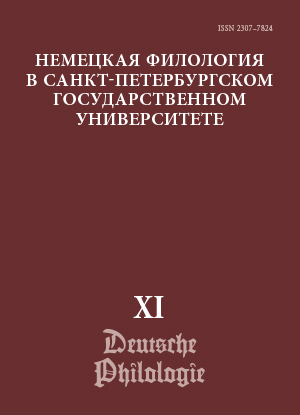Femininity in German and Russian comic media discourse in the late 19th — early 20th centuries
Abstract
The article deals with linguodiscursive and linguoculturological aspects of mass-media humoristic and satirical representation of women in Russia and Germany in the late 19th and early 20th century. Taking into account the most relevant “feminine” topics of that time, the author studies the features of gender stereotypes’ construction which are typical for the given linguocultures. Particular attention is paid to the small types of media texts (caricatures, captioned humorous pictures, aphorisms and jokes) focusing on the structures, semantics and pragmatics of the texts. German illustrated periodicals “Simplicissimus”, “Der wahre Jacob” and the Russian ones such as “Strekoza”, “Oskolki”, “Satirikon” etc. are used as the research material. Traditional methods of semantic, textual and pragmalinguistic analysis are used to describe the corpus of examples. Due to historically determined factors (e. g. development of industry, increase of urban population, spread of literacy), the issue of gender equality, women’s emancipation, social, legal and political role of women became more and more acute in this period, which was reflected in the mass entertainment press. Along with the traditional image of women as lovers, mothers, etc., the discourse of popular comic editions of the period under study also includes a comic image of a “new” (emancipated) woman, which is constructed by different means. The article analyzes the linguistic means of constructing femininity in comic media discourse, identifying the dominant semantic meaning of discursive representation of women in entertainment media. The present study attempts to explore the linguistic side of the topic of stereotypical representations of women. Particular attention is paid to the cultural specificity of gender representations. The novelty of the research is in the insufficient study of gender stereotypes in German and Russian-language print media, both in the linguistic and diachronic aspects.
Keywords:
gender, stereotype, feminity, discourse analysis, comic discourse, satire, media discourse, small-format text type
Downloads
References
Литература
References
Downloads
Published
How to Cite
Issue
Section
License
Условия передачи авторских прав на статьи и рецензии, опубликованные в ежегодном периодическом издании «Немецкая филология» регулируются условиями Лицензионного Договора автора с Санкт-Петербургским государственным университетом. В соответствии с Лицензионным Договором опубликованные материалы находятся в открытом доступе, а авторам бесплатно предоставляется неограниченные возможности их распространения и самостоятельного архивирования.




